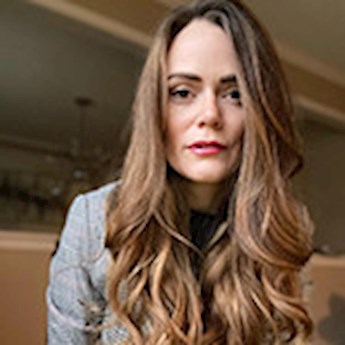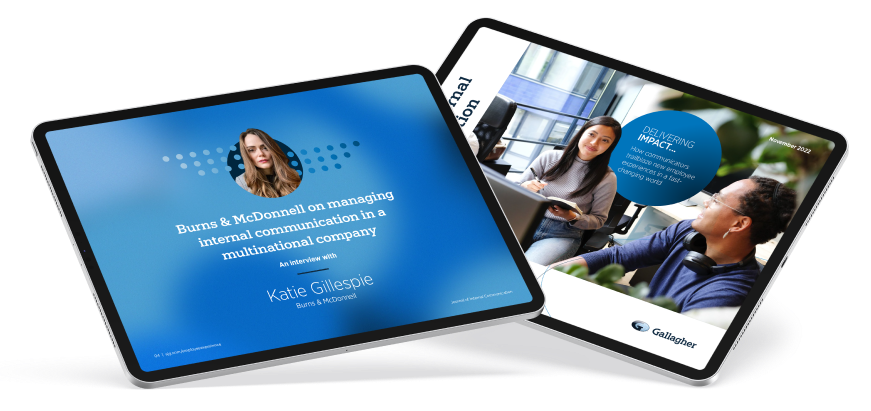Taking a decentralized approach has enabled architecture, engineering and construction company Burns & McDonnell to deliver more targeted communications to its global workforce. Head of Internal Communication Katie Gillespie explains how that's helped her team and the business at large.
What started more than 100 years ago as a small business has grown into a global organization with over 12,000 employees.
As an employee-owned business, Burns & McDonnell values and recognizes the importance of transparency and trust, paramount within the organization. Internal communication plays a big part in building a culture that focuses on building trust, community engagement and the employee experience.
Although most employees are still based in the United States, more than 2,000 work in places such India, Canada, England, Mexico, and the Philippines.
"Our firm continues to evolve, as we expand our location footprint and the services we offer," says Katie Gillespie, Head of Internal Communication who has been with Burns & McDonnell for six years. "We've had to adapt to better communicate on a multinational level and with various profit and loss organizations. We're a complex organization and with that new challenges arise when it comes to ensuring consistent messaging across the organization."
"The COVID-19 pandemic brought new challenges too. We were trying to communicate with people in literally hundreds of locations. But it also shone a light on how important internal communication was to our company. It showed us we had gaps in our existing communications structure."
Localized content
Rising to those challenges meant adopting a different approach that better reflected the newly evolved organizational make-up.
"Most of people's day-to-day experience is what they receive locally, from their profit and loss organization or their location, not from the corporate level," says Katie. "Our organizational evolution presented us with a unique opportunity. We considered how we can make things as inclusive as possible to people's experiences in different groups and locations throughout the world."
The internal communication function had grown substantially since Katie arrived. However, the size of the business meant it was relying on other colleagues outside her team to support some of the communications activity. There was a risk of inconsistent messaging. So, the team looked for ways to extend its influence over those communications, while empowering more people across the organization to communicate.
The team instituted a decentralized content structure for the company intranet, MacCentral. Every profit and loss organization, location, and corporate service group nominated its own MacCentral Captains and contributors.
"All our companies and subsidiaries are on the same dynamic intranet," says Katie. "But there was no way our team could create enough content for that, so we created the MacCentral Captains network.
"It's been really powerful. There has been so much more content than we could have ever produced as just a central team. And by empowering the captains to do what's best suited to their areas, we've been able to communicate much more effectively and created a better employee experience."
Global impact
As well as decentralizing the content creation, Burns & McDonnell has also established Communications Impact Groups that focus on its different profit and loss organizations and locations. These groups meet monthly to collaborate and share best practices and ideas.
In addition, more than half of the company's profit and loss organizations now fund an internal communications expert for their area, who sits within the Internal Communication function. These Internal Communications Strategists report to Katie, who looks after their training, resources and career growth. While part of the central team, they are solely dedicated to their specific group.
"Having dedicated resources for our profit and loss organizations sit on the internal communications team has been really beneficial," says Katie. "You get more buy-in if people feel involved. It's allowed us to collectively formulate best practices and share ideas."
"What's been a real game changer for our group is creating a team that is made up of people drawn from all walks of life. We have English graduates, former teachers, people who've worked in marketing and PR and colleagues previously involved in Human Resource functions. And we've found the different skillsets from each of those backgrounds are transferable. It's lifted the entire function."
Dedicated resource
Three dedicated resources on the internal communications team have provided opportunities for additional efficiencies on the team, specifically in the areas of intranet strategy and content development.
"We have one communication strategist who manages our intranet strategy. She looks at the governance, the content strategy, execution and how we can continually improve it," says Katie. "Then two other team members focus on creating content such as video, animation and graphics. This has enabled us to become so much quicker because we can produce higher-level content without external help."
The overall internal communications strategy is paying off, with tracked engagement growing across the business. But for Katie, one of the biggest measures of success is how the new service model has created deeper relationships.
"If one of our leaders is working on a difficult topic, the question I ask is: 'are they turning to us for help?'" she says. "And we've seen a lot more of that over the last few years. People are now asking for our help in a way they weren't before. That demonstrates our approach to relationship building and establishing trust is working."



